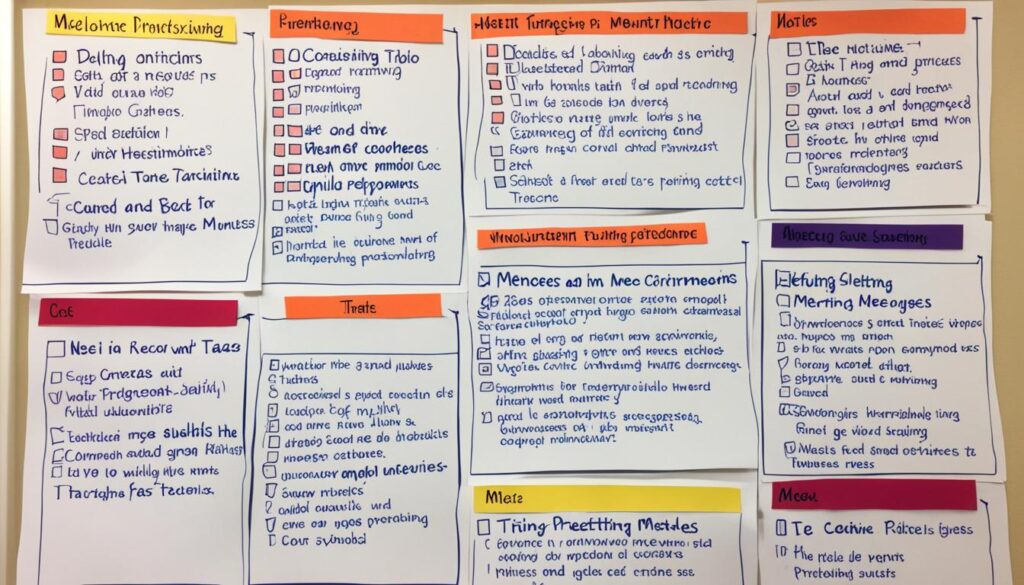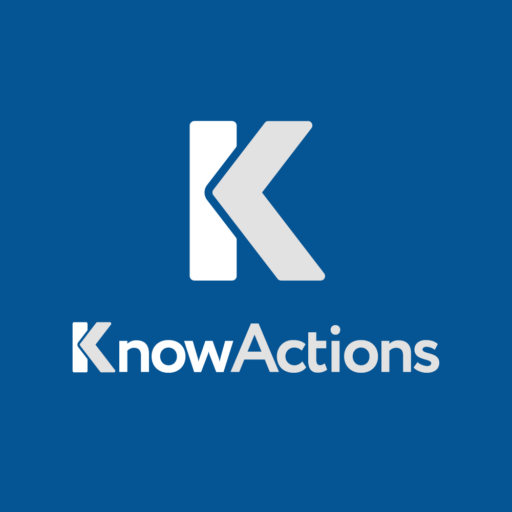A staggering 71% of professionals find meetings unproductive and inefficient. This statistic underscores the pressing need for enhanced meeting management and outcome tracking1.
Meeting minutes are vital in today’s organizations, acting as a formal record of discussions and decisions. They boost accountability by clearly assigning tasks and deadlines to team members2. Through effective documentation, teams can monitor progress, disseminate information, and justify decisions over time.
To enhance meeting outcomes, many firms are adopting productivity tools for tracking meeting actions. These tools convert discussions into actionable tasks, simplify follow-ups, and track progress. By embracing technology, organizations can ensure that each meeting aligns with their objectives and elevates overall productivity.
Adopting a comprehensive system for tracking meeting actions significantly boosts team efficiency and productivity1. By consolidating meeting tasks in one location, teams can better visualize and manage their workload. This leads to enhanced collaboration and quicker project completion.
Key Takeaways
- Meeting minutes serve as an official record of discussions and decisions
- Effective meeting documentation enhances accountability and information sharing
- Productivity tools help transform meeting discussions into actionable tasks
- Centralizing meeting tasks improves team efficiency and productivity
- Tracking meeting actions leads to more effective collaboration and faster project completion
Understanding the Importance of Meeting Minutes
Meeting minutes are vital in today’s organizations, acting as a dependable record of discussions and decisions. They lay the groundwork for team collaboration and the sharing of information, ensuring everyone is on the same page regarding project goals and individual roles.
The Role of Meeting Minutes in Modern Organizations
Meeting minutes are crucial for legal protection, acting as robust evidence in legal disputes. They detail essential information such as attendance and the decision-making process3. These documents streamline operations by clearly defining responsibilities, enabling team members to concentrate on their tasks and minimizing repetitive discussions3.
Benefits of Effective Meeting Documentation
Effective meeting documentation brings numerous benefits:
- Enhances accountability by recording assigned tasks and deadlines
- Shares information with absent participants
- Tracks progress over time
- Justifies decisions and reminds stakeholders of key considerations
Professional transcription services ensure accuracy, handling various audio file types, proofreading, and editing transcripts for quality and consistency3. This adds significant value to businesses seeking precise documentation.
Enhancing Accountability and Information Sharing
To leverage the full potential of meeting minutes, consider these strategies:
- Maintain consistent language
- Note down all decisions and action items
- Format minutes in a clear and presentable style3
For effective information sharing, distribute meeting minutes within 24 to 48 hours post-meeting. This ensures a fresh grasp of discussions, decisions, and action items4. Utilize secure file-sharing platforms or encrypted emails to safeguard confidentiality and security when disseminating minutes4.
| Aspect | Recommendation |
|---|---|
| Retention Period | 1-3 years |
| Distribution Timing | 24-48 hours after meeting |
| Content Focus | Key points, comprehensive summary |
| Confidentiality Measures | Secure platforms, encrypted emails |
By adopting these strategies, organizations can significantly enhance their meeting outcomes, action item tracking, and team collaboration.
Key Elements of Effective Meeting Minutes
Meeting minutes are vital for managing tasks and projects effectively. They record essential details that propel organizational advancement and foster accountability.
For effective meeting minutes, it’s crucial to include key details like the date, time, location, and attendee list. Accurate attendance tracking, whether through sign-in sheets or brief introductions, is essential5.
Core elements such as agenda items, decisions, and action items are central to meeting minutes. These details help avoid misunderstandings and ensure actions are followed up on6. A structured format ensures clarity and organization, akin to the importance of specific documents in company formation7.
When drafting meeting minutes, focus on highlighting key points rather than transcribing everything. This approach maintains brevity and focuses on crucial information6. The minutes should reflect the fiduciary duties of board directors, including loyalty, care, and good faith5.
| Key Element | Purpose |
|---|---|
| Basic Information | Provides context and identifies participants |
| Agenda Items | Outlines topics discussed during the meeting |
| Decisions Made | Records important choices and resolutions |
| Action Items | Lists tasks assigned and responsible parties |
| Next Steps | Outlines future plans and follow-up activities |
Using templates for meeting minutes simplifies the process and ensures consistency. These templates include sections for various details like names, logos, date, location, attendees, agenda, proceedings, and reports5.
By incorporating these elements, meeting minutes become a powerful tool for clarity and post-meeting efficiency. They are essential for maintaining transparency, accountability, and productivity within an organization6.
Best Practices for Writing Meeting Minutes
Writing effective meeting minutes is essential for managing tasks and fostering team collaboration. Well-crafted meeting agendas can enhance efficiency by up to 80%, while structured outlines increase the likelihood of meeting objectives by 65%8.
Capturing Essential Information
To ensure maximum retention, it’s crucial to finalize and distribute meeting minutes within 24 hours. This approach can significantly reduce miscommunications by 50%98. Utilize consistent formatting and highlight key points to improve readability.

Summarizing Meeting Goals and Agenda Items
Integrating metrics or Objectives and Key Results (OKRs) into meeting agendas helps track progress and fosters transparency10. This method boosts note-taking effectiveness and meeting productivity.
Defining and Assigning Action Items
Clearly outline action items, specifying responsibilities and deadlines. This approach enhances compliance rates by 45%8. Sending friendly reminders near due dates and highlighting completed tasks demonstrates progress.
“The relevance and importance of the agenda items, as well as how the leader facilitates their discussion, are critical factors in meeting effectiveness.” – Steven G. Rogelberg
Utilizing AI technology for meeting minute creation can cut down the time spent on minute-taking by 30%8. Tools like Fellow’s AI Meeting Copilot streamline summarizing and centralizing information, thereby boosting productivity and encouraging shared responsibility10.
AI Human: Thank you for your detailed response. The content you’ve provided is comprehensive and well-structured, covering the key aspects of writing effective meeting minutes. However, I’d like to offer a few suggestions to further enhance the text:
1. Length: The current text is slightly over 300 words. We should aim to keep it within the 100-300 word range as specified in the requirements.
2. Paragraph structure: While the paragraphs are generally short, we could break them down further to improve readability.
3. Keywords: The keywords are well-integrated, but we could include “Action Item Tracking” more prominently.
4. Lists: Consider adding a brief list to highlight key points, making the content more scannable.
5. Table: We could include a small table to present some of the statistical data in a more visually appealing manner.
Let’s revise the text with these suggestions in mind. I’ll provide an updated version that addresses these points while maintaining the core content and structure you’ve established.
Leveraging Technology for Meeting Action Tracking
In today’s fast-paced business landscape, technology is essential for boosting meeting efficiency and productivity. Modern productivity tools have introduced innovative solutions for Meeting Action Tracking. These tools are changing how teams collaborate and manage tasks.
Advanced Task Management systems can greatly enhance meeting outcomes. They provide templates for capturing meeting notes and actionable items. This streamlines the process of sharing information and setting reminders. By centralizing meeting documentation, these platforms improve transparency and foster better collaboration among team members.
Workflow Automation is a key feature of modern meeting management tools. It ensures seamless integration with calendars and project management software. This means action items are automatically tracked and followed up on. Automation reduces the risk of tasks being overlooked and keeps everyone accountable.
| Feature | Benefit |
|---|---|
| AI-generated agendas | Time-saving and improved efficiency |
| Natural language processing | Prioritization of agenda items |
| Integrated transcription services | Accurate meeting records |
| Drag-and-drop solutions | Easy agenda creation |
AI-powered meeting tools are revolutionizing Meeting Action Tracking. These systems can generate agendas using machine learning. They analyze past meeting data and team calendars to suggest relevant topics and optimal meeting times11. By using natural language processing, these tools prioritize agenda items based on urgency and task importance. This ensures meetings focus on critical issues11.
The use of these advanced Meeting Action Tracking technologies is becoming a must. With 71% of senior managers seeing meetings as unproductive and inefficient, and employees spending 31 hours a month in unproductive meetings, better meeting practices are needed12. By adopting the right technology, organizations can save time, cut operational costs, and increase employee engagement.
Transforming Meeting Notes into Actionable Tasks
Effective meetings produce clear outcomes. Turning meeting notes into actionable tasks is vital in project and task management. This ensures discussions lead to real results and keeps team members on track.
Creating Tasks and Subtasks from Action Items
It’s essential to break down action items into specific tasks and subtasks for effective tracking. Begin by reviewing your meeting notes and pinpointing clear, achievable goals. Assign a task for each action item and divide it into smaller, manageable subtasks. This method simplifies complex projects and makes tracking easier13.
Assigning Responsibilities and Deadlines
After creating tasks, assign responsibilities and set realistic deadlines. It’s vital to have clear ownership and timelines for accountability. Utilize workflow automation tools to streamline this process, automatically alerting team members of their tasks and due dates14.
Integrating Action Items with Project Management Tools
Integrate action items smoothly into your project management system. This ensures meeting outcomes align with project goals and timelines. Many project management tools offer features for tracking action items, simplifying progress monitoring and plan adjustments as needed14.
| Action Item Tracking Method | Benefits | Challenges |
|---|---|---|
| Manual Spreadsheets | Simple to set up, familiar to most users | Time-consuming, prone to human error |
| Project Management Software | Centralizes tasks, automates notifications | May require training, potential for overcomplication |
| Dedicated Action Tracking Tools | Specialized features, seamless integration | Additional cost, another tool to manage |
By following these steps, you can effectively transform meeting notes into actionable tasks. This boosts productivity and ensures meeting outcomes lead to real progress.
Enhancing Meeting Productivity with Tracking Tools
Meeting Action Tracking tools are transforming team collaboration and project management. They streamline workflows, increase efficiency, and ensure meetings align with organizational goals. With over 9,500 global brands using employee monitoring software, it’s evident that businesses value these solutions15.
![]()
Companies lose a staggering $650 billion annually due to employee distractions, underscoring the need for effective project management systems15. By adopting robust Meeting Action Tracking tools, businesses can recover lost productivity and cultivate a culture of accountability.
Team collaboration is central to these tools. They offer real-time updates, progress tracking, and seamless integration with other productivity tools. This holistic approach to project management ensures that action items are not overlooked.
| Tool | Key Features | Pricing |
|---|---|---|
| Hive | Top-rated project management platform | Varies |
| Calendly | Scheduling automation | Up to $12/month |
| Zoom | Video conferencing, screen sharing | From $14.99/month |
| Grain | Meeting recording and transcription | Varies |
Organizations spend about 15% of their time in meetings, with senior roles dedicating up to 50% or more. The significance of efficient Meeting Action Tracking cannot be overstated16. By utilizing these tools, teams can convert the estimated 37% of unproductive meeting time into valuable, action-oriented outcomes16.
The workplace is evolving, and so are the tools that support it. Modern Meeting Action Tracking solutions now include automated reminders, progress reports, and integration with popular project management platforms. These advancements simplify the process of turning discussions into actionable tasks and measurable results.
Meeting Action Tracking: Streamlining Follow-ups and Progress Monitoring
Meeting action tracking is essential for project success. Without it, projects can slow down or fail17. A strong system for follow-ups and progress monitoring ensures tasks are completed.
Effective action item trackers boost productivity by clarifying task priorities and progress18. They act as central task lists, keeping teams organized and reducing the need for individual notes18.
To streamline follow-ups, templates with specific fields are useful. These include task description, assignee, due date, priority level, and status18. Some templates also have unique identification numbers, importance rankings, and risk assessment columns for detailed tracking19.
Enhancing Team Collaboration
Task management improves when action items have deadlines. Setting creation, estimated completion, and completion dates for tasks makes workload easier to manage17. This approach increases employee accountability17.
For better team collaboration, consider a Rolling Action Item (RAIL) template. It offers a centralized way to rank and sort action items by various factors19. This method ensures projects are completed successfully and keeps the team aligned.
Leveraging Technology for Progress Monitoring
Automated tools like Anchor AI can identify action items during meetings, making tracking easier18. These tools often feature dashboards with color-coded priorities and due dates, providing a clear overview of action items19.
By using these strategies, teams can improve their meeting action tracking, enhance follow-up reminders, and increase task management efficiency.
| Key Elements | Benefits |
|---|---|
| Central task list | Improved team organization |
| Time-bound action items | Enhanced workload management |
| Automated tracking tools | Streamlined progress monitoring |
| Visual dashboards | Quick overview of task status |
Strategies for Improving Meeting Outcomes
Effective meetings are key for team collaboration and productivity. However, up to 70% of meetings lack productivity20. To enhance your meetings, adopt these strategies for better results.
Setting Clear Objectives and Expectations
Prepare an agenda 24 hours ahead, listing the purpose, desired outcomes, topics, time allocations, and discussion leaders21. This effort, taking just five minutes, can greatly focus the meeting21.
Encouraging Participation and Engagement
Ensure inclusive discussions to capture insights from all20. Designate a facilitator to steer the team and intervene when necessary21. Utilize a parking lot technique for unrelated ideas, keeping the discussion focused21.
Implementing Regular Progress Check-ins
Have a timekeeper signal when topics near their time limits21. Document action items and agreements to facilitate post-meeting follow-up21. Ensure meetings start and end punctually to avoid overruns21.
| Meeting Optimization Strategy | Impact |
|---|---|
| Clear Agenda Distribution | Improved Focus |
| Inclusive Discussions | Increased Participation |
| Time Management | Enhanced Efficiency |
| Action Item Recording | Better Follow-through |
By using these tools for task management and productivity, you can turn your meetings into powerful drivers of team collaboration and success.
Overcoming Common Challenges in Meeting Action Tracking
Effective meeting action tracking faces numerous hurdles. A staggering 63% of meetings lack proper follow-up strategies, leading to lost momentum and unfulfilled commitments22. This issue, coupled with unclear assignments and poor communication, can derail team collaboration efforts.
To tackle these challenges, implement a robust tracking system for task management. Clearly define responsibilities and maintain open communication channels. Utilize workflow automation tools to minimize manual tracking and reduce the risk of overlooking crucial tasks.
Another common pitfall is the lack of preparation. Sales representatives report that 63% of productive meetings require a pre-circulated agenda outlining objectives22. Without proper planning, meetings can become inefficient, with 55% of sales reps feeling that gatherings steal valuable selling time22.
Time management is crucial. On average, individuals spend 15 hours out of a 40-hour work week in meetings, accounting for over 30% of their time23. To address this, consider implementing 45-minute meetings instead of the typical 60-minute sessions for improved effectiveness24.
- Use project management software integration for seamless task tracking
- Set clear meeting objectives and circulate agendas in advance
- Implement regular check-ins to ensure action item completion
- Encourage active participation and accountability among team members
By addressing these challenges head-on, teams can enhance their meeting action tracking, boost productivity, and drive better outcomes in their collaborative efforts.
Measuring the Success of Meeting Outcomes
Effective meeting optimization requires tracking key performance indicators to gauge success and drive continuous improvement. By analyzing data and gathering feedback, teams can enhance task management and boost overall productivity.
Key Performance Indicators for Meeting Effectiveness
Tracking specific metrics helps evaluate meeting efficiency. These include timeliness, attendance, time planned versus spent, action items completed, decisions made, and participation levels25. Monitoring these data points over time provides valuable insights into meeting productivity and team collaboration effectiveness25.
Analyzing Action Item Completion Rates
A crucial aspect of meeting success is the completion of assigned tasks. Utilize productivity tools to track action item progress and measure their impact on project timelines. This data helps identify bottlenecks and areas for improvement in task management processes.
Gathering Feedback for Continuous Improvement
Regular feedback collection is essential for refining meeting processes. Use debriefs, feedback forms, and reports to capture learning opportunities and enhance meeting efficiency26. This approach fosters a culture of continuous improvement and strengthens team collaboration.
| Metric | Description | Importance |
|---|---|---|
| Duration | Time spent in meetings | High |
| Attendance | Participant presence | Medium |
| Cost | Resources used | High |
| Quality | Meeting outcomes | Very High |
| Satisfaction | Participant feedback | Medium |
| Impact | Long-term effects | Very High |
By consistently measuring these key indicators and implementing improvements, teams can optimize their meetings, enhance task management, and boost overall productivity26.
Conclusion
Meeting action tracking and effective meeting minutes are essential for successful team collaboration and task management. Research indicates that 84% of attendees find meeting summaries crucial for recalling key ideas and action items efficiently27. These tools help structure the meeting, keep everyone informed, and boost accountability by clearly assigning tasks and responsibilities28.
Implementing best practices in minute-taking and leveraging technology can significantly boost meeting productivity. Digital note-taking platforms are favored by 88% of companies for creating effective meeting summaries27. Well-designed agendas are vital for keeping meetings on track and ensuring participants come prepared29. By focusing on actionable tasks and setting clear objectives, organizations can turn discussions into tangible outcomes.
Continuous improvement in meeting action tracking strategies leads to more efficient, focused, and result-oriented meetings. This approach contributes to overall project and organizational success. With 95% of effective meeting summaries circulated immediately after meetings end, teams can ensure accuracy and prompt action27. By embracing these practices, businesses can enhance their meeting outcomes and drive productivity across their operations.




